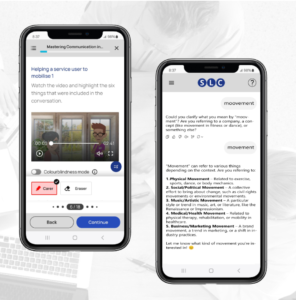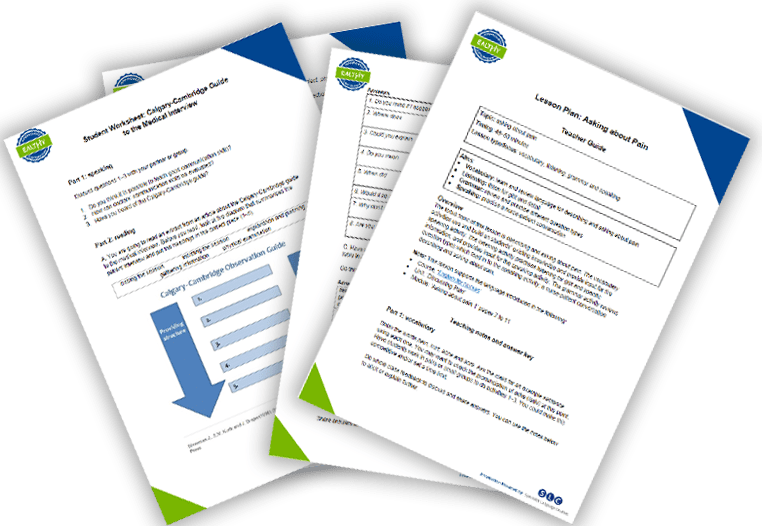
SLC win Ufi grant to develop AI language learning app for social carers
We’re delighted to have won a grant from Ufi VocTech Trust to develop an AI-driven technology solution that provides cheap phone-based language and communication skills
This lesson plan focuses on how to ask about and describe pain. It includes vocabulary, grammar and communication activities.
B1 level
● Topic: Asking About Pain
● Timing: 60-90 minutes
● Lesson Type/Focus: mixed – vocabulary development, grammar consolidation, listening and speaking skills development
● Vocabulary: learn and practise language for describing and asking about pain
● Listening: improve listening skills for gist and detail
● Grammar: improve ability to use different question types
● Speaking: improve clinical speaking skills through role play
The focus topic of this lesson is describing and asking about pain. Students’ existing vocabulary is activated with a short vocabulary discussion, after which a dialogue is used first to practise listening for gist and detail and then as the basis of a gap-fill. Language from the dialogue is then exploited in the second vocabulary activity, which expands to elicit a range of language to talk about pain. Different question types, as demonstrated in the dialogue, are explored in the next activity before a role play between a nurse and a patient closes the lesson by giving practice with language from all the previous activities.
Note: while this lesson plan works as an independent plan, it also supports the language introduced in the following:
● Course: Online English for Nurses: Getting the Essentials Right’.
● Unit: Discussing Pain
● Module: Asking about pain 1
Write up the words pain, hurt and ache and ask the class for an example sentence using each one. You may want to check the pronunciation of ache (/eɪk/) at this point. Note any variation in word form, e.g. hurts, aching and elicit other members of the word families, e.g. painful.
Put students into pairs and give them a few minutes to think of sentences. Then ask for feedback to class and discuss where appropriate, e.g. to correct.
Now ask students to think of words for specific pains, e.g. headache, neuralgia. They should make a list in their pairs.
In turn, ask each pair to say an item from their list. Check their pronunciation, then make a master list for the class.
headache, toothache, backache, earache, neuralgia, fibromyalgia, heartburn, sore throat, cramp, indigestion, period pain, migraine
● Direct students to the first set of questions and check students understand them.
● Play the recording from the conversation between the nurse and the patient once and give pairs/groups a moment to confer and make some notes on the answers.
● Check answers through class feedback.
His lower back; he hurt it in a bike accident.
A long time (he says “for years”).
Sudden movements and lifting heavy objects.
He has trouble getting comfortable. It sounds like it’s also affecting his ability to sleep.
● Now ask students to read through the dialogue transcript and imagine what the missing words are.
Encourage them to analyse the transcript and discuss the meaning and structure of the missing language. This is an opportunity to practise varying levels of focus: reading the whole conversation without worrying about the gaps will give a general idea of the topic, while looking at a shorter section will give clues as to the meaning or function of the missing statement and concentrating on the grammar of a single line may indicate the type of language needed to fill the gap.
● Ask the class to study the phrases below the dialogue and try to fit them into the spaces. Ask them to compare them with the answers they thought of.
● Play the video/audio recording so they can check their ideas and change them where necessary. This is in the course: Online English for Nurses: Getting the Essentials Right’, as indicated above, or is available here.
● Use whole class feedback to check the correct answers.
Nurse: Hi William. How are you (1) today?
Patient: Oh. I’m OK apart from this pain. I just can’t get comfortable.
Nurse: Oh right. Is it OK if I ask you some questions (2) about the pain?
Patient: Yeah, sure.
Nurse: First, can you tell me (3) where the pain is?
Patient: It’s in my lower back. Right here at the base of the spine. I had a bike accident a few years ago and hurt my back and my right hip.
Nurse: I see. So, is the pain in your back (4) and your hip?
Patient: No, I’ve only got back pain now. My hip’s OK. But I’ve had back pain for years now.
Nurse: What (5) type of pain is it?
Patient: I’m sorry, I don’t understand what you mean. It’s back pain.
Nurse: Yes, I understand but I was trying to find out if (6) it’s a sharp pain or a dull ache. If you have a sharp pain, it is usually a (7) short-term pain, whereas a (8) dull ache can be a type of (9) chronic pain.
Patient: Oh right. I understand what you’re asking now. It’s mostly a dull ache, except if I move suddenly or try to pick up something heavy. Then I get a sharp pain.
Nurse: You said your back (10) is hurting now, right?
Patient: Yes, it’s quite painful. I couldn’t stay in bed any longer.
Download the complete lesson plan and student worksheet:

We have many more available on our partner’s website. EALTHY is a unique international association for
English for Healthcare teachers, writers and researchers. It offers members a growing bank of lesson plans, OET resources, articles and research summaries, as well as free and discounted access to conferences, journals, publications and SLC courses!
Through our partnership, we publish at least three new plans in the EALTHY Members Area every week. So, if you’re a teacher looking for excellent resources, now is the time to join an international English for Healthcare community and take advantage of everything EALTHY has to offer.
Annual memberships are available for teachers and for institutions. We hope very much to see you there!
Get your monthly updates and latest materials on Medical English

We’re delighted to have won a grant from Ufi VocTech Trust to develop an AI-driven technology solution that provides cheap phone-based language and communication skills

Back to Menu ↩ What is the UK Foundation Programme? The UK Foundation Programme is a two-year, structured, work-based training programme which is designed to
